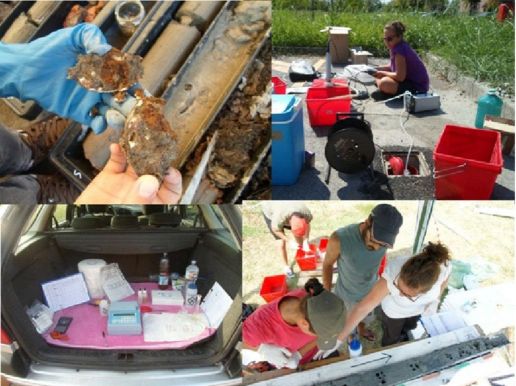Contaminant hydrogeology: monitoring and modeling

The following specific lines of research are currently active at the BiGeA department:
(1) chlorinated solvents behavior (mainly chlorinated ethenes) in porous sedimentary aquifers. This type of contamination is widely present in the SE sector of the Po Valley due to inadequate disposal of industrial waste in landfills or accidental spillage at industrial plants. Among the main results obtained through this research line, a strong correlation has been defined between the accumulation of Vinyl Chloride (VC) in groundwater, a highly carcinogenic contaminant, and the widespread occurrence of silty-clayey deposits rich in peat in the surface alluvial sedimentary succession ("swamp facies association"). These deposits function as biogeochemical "reactors" for the dechlorination of PCE and TCE, causing production and accumulation of VC. In the same hydrogeological context, the integrity of aquitards with respect to chlorinated solvents in dense non-aqueous phase (known as DNAPL - Dense Non-Aqueous Phase Liquid) has been investigated. This allowed defining the degree of protection provided by the aquitards to the underlying aquifers in case of contamination by chlorinated solvents. The research concerning the chlorinated solvents behavior is based on the sampling of sediment and water with high vertical resolution, carried out by means of multi-level systems. Sediment and groundwater sampling are complemented by detailed stratigraphic-sequential reconstructions carried out in collaboration with the research group led by Prof. Alessandro Amorosi (BiGeA);
(2) application of isotopic techniques to identify the polluter in sites contaminated by chlorinated solvents. The results obtained through this line of research show that the 13C/12C isotope ratio of chlorinated ethenes molecules defines whether a contamination is caused by the disposal/spillage of industrial products rather than by chlorinated pitches as production wastes deriving from chloromethanes synthesis. The approach has been effectively applied to identify the contamination responsible in the case of the Caretti site (Ferrara) and is being applied at the Bussi sul Tirino (Pescara) site;
(3) analysis of water isotopes to define the aquifer intrinsic vulnerability to contamination. The stable isotope signature of groundwater (18O/16O, 2H/1H) can be employed to quantify the recharge rates reaching the aquifers from different sources. This technique is known as End-Member Mixing Analysis (EMMA). In the Po Valley context, where the hydrogeological system consists of a series of overlapping aquifers with different confinement rates, such recharge estimation can translate into an assessment of the vulnerability of the respective aquifers. A high rate of vertical recharge reaching the aquifer corresponds to a high level of aquifer vulnerability to contamination sources from the surface. Vice versa, a high rate of lateral recharge corresponds to a low level of vulnerability.
(4) phytoscreening of volatile organic contaminants (especially chloroethenes) in plant matrices, such as mature hardwoods, to indirectly characterize the contamination in underground matrices (water and soil gas). The technique underlying the research is advantageous for its cost-effectiveness and rapidity. Parallel to the well-known phytoremediation, this technique exploits the absorbing capacity of plants for the delineation of plumes of underground contamination by volatile organic compounds. Chlorinated ethenes are detected by analyzing micro-cores of tree trunks sampled with an incremental borer. In the laboratory, traditional methods for the analysis of solid materials, such as soils and waste, are used to reveal the contaminants concentrations. The correlation between the concentrations found in underground and plant matrices depends on numerous environmental factors. This research focuses on on how hydrogeological conditions influence the effectiveness of phytoscreening for a correct delineation of the underground contamination. The research is carried out in over eight sites contaminated by chlorinated ethenes in the Emilia-Romagna region.
The four specific lines of research described above are conducted in collaboration with the Helmholtz Center for Environmental Research UFZ - Department for Isotope Biogeochemistry (Leipzig, Germany), Institute of Groundwater Ecology - Helmholtz Zentrum München (Germany), G360 Centre for Applied Groundwater Research - School of Engineering - University of Guelph (Ontario, Canada), and the Regional Environmental Prevention Agency (ARPAE, Emilia-Romagna).
Relevant publications (2013-2020):
- Filippini M., Parker B.L., Dinelli E., Wanner P., Chapman S.W., Gargini A. (2020). Assessing aquitard integrity in a complex aquifer – aquitard system contaminated by chlorinated hydrocarbons. Water Research, 171: 115388.
- Filippini M., Amorosi A., Campo B., Herrero-Martìn S., Stumpp C., Nijenhuis I., Parker B.L., Gargini A. (2016) - Origin of VC-only plumes from naturally enhanced dechlorination in a peat-rich hydrogeologic setting. Journal of Contaminant Hydrology. DOI: 10.1016/j.jconhyd.2016.07.003
- Filippini M., Nijenhuis I., Kümmel S., Chiarini V., Crosta G., Richnow H. H., Gargini A. (2018): Multi-element compound specific stable isotope analysis of chlorinated aliphatic contaminants derived from chlorinated pitches. Science of The Total Environment, 640-641, pp. 153-162.
- Nijenhuis, I., Schmidt, M., Pellegati, E., Paramatti, E., Richnow, H.H., Gargini, A. 2013. A stable isotope approach for source apportionment of chlorinated ethenes plumes at a complex multi-contamination events urban site. Journal of Contaminant Hydrology, 153, 92-105.
- Wachniew P., Zurek A.J., Stumpp C., Gemitzi A., Gargini A., Filippini M., Rozanski K., Meeks J., Kvaerner J., Witczak S. (2016) – Towards Operational Methods for the Assessment of Intrinsic Groundwater Vulnerability: a Review. Critical Reviews in Environmental Sciences and Technology. DOI:10.1080/10643389.2016.1160816
- Filippini M., Stumpp C., Nijenhuis I., Richnow H.H. Gargini A. (2015) - Evaluation of aquifer recharge and vulnerability in an alluvial lowland using environmental tracers. Journal of Hydrology, 529, 1657-1668.